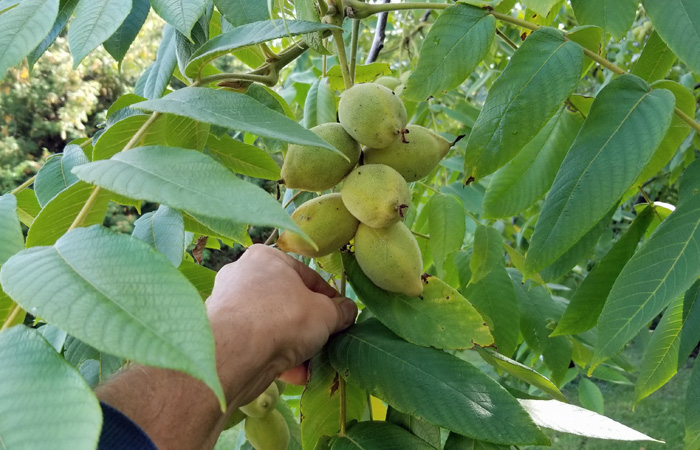Deeply Rooted
Nuts About Trees

Nope, I’m not talking about my eccentric hobby that turned into Falk Nurseries. I’m thinking of actual nut trees that grow here in Manitoba. As part of this continuing series, I would like to discuss the little-known black walnut. They can become a full-grown tree here in Manitoba. There are several at the legislative building. I have three 20-30 footers planted at my previous yard near Kleefeld. My original seed was taken at the Morden research station over 15 years ago. Although I do not know their original Source it is fairly safe to assume they are from Mid-Minnesota. Black Walnut are not hardy enough to use as a shelterbelt tree, but they will make good trees inside a yard where they get wind protection. We actually grow a fair number of trees that would qualify in this category. Black walnuts would have similar hardiness requirements to apricot, sugar maple, and Autumn Blaze maple. An area well sheltered from the north and west winds, preferably most winds would be a great start. If you plant them in a low moist, are they may not shut down in fall and freeze off more readily. If they are growing in a well-drained area with good soil, they will do the best. You can always add water to a raised area, but you cannot drain a low spot.
Black walnut can grow a couple of feet a year. The leaves are a nice dark green and compound like black ash but with more leaflets. The round nuts are edible but have thick shells. You will need a vice grip or hammer to crack them open. They ripen and fall off the tree in early October. They have a fleshy green husk making the nut appear slightly larger than a golf ball. Once the green husk is removed the actual nut is smaller than a golf ball. They can be stored for several months in this form. They have a rich and oily flavour. Where they are commercially grown, they are used often for confectionery purposes. The tree can become as large as an American elm and similar in shape. The wood is prized for its chocolate tone, texture and strength. Personally, I just enjoy viewing the tree. Growing up in the Prairies where nuts trees are absent and not native, they seem exotic.
They make picturesque trees for sheltered settings. There is a natural herbicide called juglone produced in the roots that does inhibit growth of some plant varieties. Grass will grow under the tree and there are resistant plants but if you’re planning a Garden nearby double check that list.
We sell third-generation Manitoba grown trees and strongly suggest a proven local source if you want to give black walnut a go. Next week we’ll talk about the other native Minnesota Walnut able to grow in our climate. The white Walnut also known as butternut.
On a visual scale my opinion is that Butternut trees look more tropical than black walnut. The leaves are long up to 15 to 20″ they are lighter green than black walnut. The tree is broader but not as tall. If you look up their hardness rating, they seem to be harder than black walnut. I would question that. Both have their own ways of showing struggle in our climate. Black walnuts tend to tip freeze a bit more when they’re young where is I’ve seen butternuts crack of a little more often on the southwest side where the sun expands and the cold contracts the bark. Having said that both can function very well and protected areas.
Butternut can be tapped like a maple tree, go figure, who would have thought. Apparently black walnut can be to, but it seems to have a bit harsher flavour. I’ve never tried it but Research indicates Butternut sap is quite mild and sweet.
Besides being good-looking and having sweet sap this tree produces a mild rich and oily tasting nut. Only challenge is cracking it you could use the hammer again. You can definitely tell the difference between a black walnut which is round and very dark and the white wall nut which has an oblong shape with a pointed bottom end. Don’t be too surprised if you have more work for Less results shelling either of these walnuts. The shells are thick, and the nuts are smaller than the English walnuts purchased in the store.
There are certain bragging rights about having a tree in your yard that no one can identify and then find out that it is rather exotic. It’s just fun, possible and beautiful.
I won’t do a blog on Manchurian Walnut because it is rather rare and hard to find. Plus, it’s difficult to tell it apart from the butternut, a little redundant to the average eye Having said that if you’re a keener they do also grow here given a similar location to the other two walnuts mentioned above.




